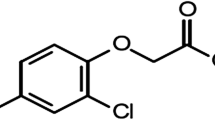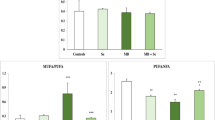Abstract
The aim of this investigation was to determine levels of liver vitamins A and E and blood biochemical and hematological parameters in the enflurane anesthesia of rats. Fifty adult male Wistar rats were used in this study. All rats were randomly divided into five groups. The first and second groups were used as the control and anesthesia control groups, respectively, and only the placebo was intraperitoneally injected. The third group was intraperitoneally administered with vitamin E (dl/-α-tocopheryl acetate, 100 mg/kg body weight), the fourth group with Se (Na2SeO3 1.5 mg/kg body weight), and the fifth group with vitamin E and Se (dl-α-tocopheryl acetate, 100 mg/kg body weight + Na2SeO3 1.5 mg/kg body weight). This administration was done for three times with overday intervals and the second, third, forth, and fifth group rats were taken to enflurane anesthetise for 2 h.
The liver vitamin E level was slightly lower in the anesthesia control group than in control group. However, the liver vitamin E content was significantly (p < 0.05 andp < 0.01) increased in vitamin E, Se, and combination groups, whereas the vitamin A level in liver was not statistically different.
In general, plasma levels of alanine aminotransferase, creatin kinase, total bilirubin, urea, red blood cell counts, packet cell volume, and hemoglobulin values were significantly (p < 0.05 andp < 0.001) increased during the anesthesia and returned to near control values after the vitamin E plus selenium injection. However, administration of vitamin E had less effect on the hematological and biochemical parameters compared to that of selenium and their combination with vitamin E. However, the white blood cell count and levels of alkaline phosphatase, aspartate aminotransferase, total cholesterol, triglycerides, total protein, and creatinine were not statistically influenced by the anesthesia.
In conclusion, we observed that plasma levels of some enzymes and metabolites were significantly increased in the enflurane anesthesia of rats, whereas the liver vitamin E levels were slightly decreased. Therefore, we observed that vitamin E and selenium have a protective effect against anesthesia complication, but the effect of selenium appears to be much greater than the vitamin E.
Similar content being viewed by others
References
L. Packer and S. Landvik, Vitamin E in biological systems, inAntioxidants in Therapy and Preventive Medicine, I. Emerit, L. Packer, and C. Auclair, eds., Plenum, New York, pp. 93–103 (1990).
T. Ozawa,New Trends in Biological Chemistry, Japan Scientific Societies Press, Tokyo (1991).
L. R. McDowell,Vitamins in animal nutrition—comparative aspects to human nutrition: vitamin A and E. (Edited by McDowell, L. R.) Academic Press, London, pp. 10–52, 93–131 (1989).
D. C. Liebler, The role of metabolism in the antioxidant function of vitamin E,Crit. Rev. Toxicol. 23, 147–169 (1993).
H. E. Gallo-Torres, Absorption, blood transport and metabolism of vitamin E, inA Comprehensive Treatise, L. J. Machlin, ed., Marcel Dekker, New York, pp. 170–267 (1980).
E. L. Smith, R. L. Hill, I. R. Lehman, R. J. Lefkowitz, P. Handler, and A. White,Principles of Biochemistry, Mammalian Biochemistry, McGraw-Hill, London, p. 760 (1986).
A. MacPherson, Selenium, vitamin E and biological oxidation. InRecent Advances in Animal Nutrution. (Edited by Cole, D. J., and Garnsworthy, P. J.) Butterworth and Heinemann’s, Oxford, pp. 3–30 (1994).
H. Zintzen,A Summary of the Vitamin E/Selenium Problem in Ruminants, F. HoffmannLa Roche, Co., Basel, p. 12 (1971).
J. P. H. Fee, G. W. Black, J. W. Dundee, P. D. Mcllroy, H. M. Johnston, S. B. Johnston, et al., A prospective study of liver enzyme and other changes following repeat administration of halothane and enflurane,Br.J. Anaesth. 51, 1133–1141 (1979).
R. A. Van Dyke, Hepatic centrilobular necrosis in rats after exposure to halothane, enflurane, or isoenflurane,Anesth. Analg. 61, 812–819 (1982).
H. Obara, N. Maekawa, H. Hoshina, O. Tanaka, R. Chuma, S. Iwai, et al., Plasma levels of vitamin E and lipoperoxide during pediatric anaesthesia,Can. Anaesth. Soc. J. 32, 358–363 (1985).
M. Naziroglu, M. Çay, H. Şimşek, C. Günay, E. Beytut, and M. Aksakal, Plasma levels of vitamin A, E, beta carotene and glutathione peroxidase during enflurane anaesthetised dogs, Stress of Life “Stress and Adaptation from Molecules to Man, Budapest, 1–5 July (1997), p. 175.
N. C. Jain,Schalrn’s Veterinary Haematology, 4th ed. Lea & Febiger, Philadelphia (1986).
R. K. Cannon, Haemoglobin (as cyanmethemoglobin) in blood,Clin. Chem. 4, 246–251 (1958).
C. H. McMurray, W. J. Blanchflower, and D. A. Rice, Influence of extraction techniques on the determination of α-tocopherol in animal feedstuffs,J. Assoc. Off. Anal. Chem. 63, 1258–1261 (1980).
G. F. Combs and S. B. Combs, The nutritional biochemistry of selenium,Ann. Rev. Nutr. 4, 257–280 (1984).
G. W. Burton and K. U. Ingold, β-carotene: an unusual type of lipid antioxidant,Science 224, 569–573 (1984).
P. E. Berger, J. A. G. Culham, C. R. Fitz, and D. C. Hearwood-Nash, Slowing of hepatic blood flow by halothane: angiographic manifestations,Radiology 118, 303 (1976).
M. Şimşek, M. Naziroglu, H. Şimşek, M. Çay, M. Aksakal, and S. Kumru, Blood plasma levels of lipoperoxides, glutathione peroxidase, beta carotene, vitamin A and E in women with habitual abortion,Cell Biochem. Func. 16, 227–231 (1998).
E. P. Steffey, J. Zinkl, and D. Howland, Jr., Minimal changes in blood cell counts and biochemical values associated with prolonged isofluarane anesthesia of horses,Am. J. Vet. Res. 40, 1646–1648 (1979).
N. Y. J. Yang and I. D. Desai, Effect of high levels of dietary vitamin E on hematological indices and biochemical paramaters in rats,J. Nutr. 107, 1410–1417 (1977).
P. G. Reddy, J. L. Morrill, R. A. Frey, M. B. Morrill, H. C. Minocha, S. J. Galitzer, and A. D. Dayton, Effects of supplemental vitamin E on the performance and metabolic profiles of dairy calves,J. Dairy Sci. 68, 2259–2266 (1985).
M. Aksakal, M. Naziroglu, and M. Çay, The effects of selenium and vitamin E on some haematolopical and biochemical values of blood in lambs,Tr. J. Vet. Anim. Sci. 20, 185–190 (1996).
M. Naziroglu, M. Çay, M. Aksakal, and E. Akgül, The effects of vitamin E on some haematological and biochemical values in the lambs,Tr. J. Vet. Anim. Sci. 20, 39–43 (1996).
Author information
Authors and Affiliations
Rights and permissions
About this article
Cite this article
Naziroglu, M. Protective role of intraperitoneally administered vitamin E and selenium in rats anesthetized with enflurane. Biol Trace Elem Res 69, 199–209 (1999). https://doi.org/10.1007/BF02783872
Received:
Accepted:
Issue Date:
DOI: https://doi.org/10.1007/BF02783872




